Characteristics of Electromagnetic Radiation and the Acoustic Emission Response of Multi-Scale Rock-like Material Failure and Their Application
Abstract
:1. Introduction
2. Experimental System and Methods
2.1. Experimental System
2.2. Sample Preparation
2.3. Experimental Scheme
3. Experimental Results
3.1. Mechanical Deformation and Failure Characteristics of Specimens
3.2. Study on Failure Acoustic Emission Characteristics of Specimens
3.2.1. Acoustic Emission Characteristics of Specimen under Uniaxial Loading
- (1)
- There was a certain acoustic emission signal in the initial loading stage of the specimen, which was due to the fact that as the load gradually increased, the tiny holes in the specimen were gradually compacted, resulting in a certain degree of micro-fracturing.
- (2)
- During the mid-loading period, the micro-fractures tend to be active, while the acoustic emission activity increases and quickly reaches the counting peak. With the progression of time, the acoustic emission activity is gradually weakened, which is due to the density of micro-cracks in the material reaching a certain level. At this time, the energy gathered inside the material is not enough for micro-fractures to penetrate through the material and form macro-cracks.
- (3)
- After a period of stable development, due to the energy gathered inside the material reaching the energy limit that it can accommodate, the micro-cracks quickly penetrate through the material and form macro-cracks, and the acoustic emission count increases rapidly to the maximum level.
- (4)
- After the main fracturing of the specimen, the acoustic emission activity gradually decreases after a brief increase, which is due to the strong friction between the material weakening fracture surfaces, which causes the acoustic emission signal to continue to grow.
3.2.2. Acoustic Emission Characteristics of Specimen under Cyclic Loading
3.3. Study on Failure Electromagnetic Radiation Characteristics of Samples
4. Geophysical Response Law of Mine Rockburst
4.1. Electromagnetic Radiation Response Law of Rockburst
4.2. Microseismic Response Law of Rock Burst
5. Conclusions
- (1)
- Under uniaxial loading, the stress–deformation curves of the specimen have a compaction stage, linear elastic stage, elastic–plastic stage and failure stage.
- (2)
- When the sample size is small, the peak stress increases with the increase in size. When the sample size reaches 100 mm, the trend tends to converge. The AE–EMR characteristics of samples with different sizes show different variation characteristics. There is a nonlinear relationship between the cumulative acoustic emission value and the sample size. The cumulative acoustic emission count generated by the failure of the sample increases nonlinearly with the increase in the size.
- (3)
- The cumulative AE counts, AE energy and stress level of the specimen during loading compression have an exponential relationship. Under cyclic loading, the Felicity ratio of acoustic emission decreases first and then increases with the increase in stress level. When the stress level is low, the cumulative EMR counts of loading and unloading are high. With the increase in stress level, the cumulative EMR counts decrease slightly, and then increase slowly.
- (4)
- The electromagnetic radiation intensity shows a gentle trend in a period of time before the impact, and increases significantly when the impact occurs, indicating the increase in the impact risk. The microseismic hypocentral distance also shows an abnormal change trend when rock burst occurs. Therefore, this acoustic–electric anomaly can be used as a geodynamic precursor characteristic signal for rock burst monitoring and providing early warnings.
Author Contributions
Funding
Institutional Review Board Statement
Informed Consent Statement
Data Availability Statement
Acknowledgments
Conflicts of Interest
References
- Ogawa, T.; Oike, K.; Miura, T. Electromagnetic radiations from rocks. J. Geophys. Res. Atmos. 1985, 90, 6245–6249. [Google Scholar] [CrossRef]
- Gokhberg, M.B.; Morgunov, V.A.; Pokhotelov, O.A.; Khabazin, Y.G. Statistical model of distributed emitters. Trans. (Dokl.) USSR Acad. Sci. Earth Sci. Sect. 1988, 302, 1–3. [Google Scholar]
- Rudajev, V.; Vilhelm, J.; Lokajíček, T. Laboratory studies of acoustic emission prior to uniaxial compressive rock failure. Int. J. Rock Mech. Min. Sci. 2000, 37, 699–704. [Google Scholar] [CrossRef]
- Frid, V.I.; Shabarov, A.N.; Proskuryakov, V.M.; Baranov, V.A. Formation of electromagnetic radiation in coal stratum. J. Min. Sci. 1992, 28, 139–145. [Google Scholar] [CrossRef]
- Wang, E.; He, X.; Liu, Z.; Li, Z. Study on frequency spectrum characteristics of acoustic emission in coal or rock deformation and fracture. J. China Coal Soc. 2004, 29, 4. [Google Scholar]
- Wang, E. The Effect of EMR&AE during the Fracture of Coal Containing Gas and Its Applications; China University of Mining and Technology: Xuzhou, China, 1997. [Google Scholar]
- Wang, E.; He, X.; Nie, B.; Liu, Z. Principle of predicting coal and gas outburst using electromagnetic emission. J. China Univ. Min. Technol. 2000, 29, 225–229. [Google Scholar]
- Xu, W.; Tong, W.; Wu, P. Experimental study of electromagnetic emission during rock fracture. Chin. J. Geophys. 1985, 28, 181–190. [Google Scholar]
- Dou, L.; Tian, J.; Lu, C.; Wu, X.; Mou, Z.; Zhang, X.; Li, Z. Research on electromagnetic radiation rules of composed coal-rock burst failure. Chin. J. Rock Mech. Eng. 2005, 24, 143–146. [Google Scholar]
- Lu, C.; Dou, L.; Wu, X. Experimental research on rules of rock burst tendency evolution and acoustic-electromagnetic effects of compound coal-rock samples. Chin. J. Rock Mech. Eng. 2007, 26, 2549–2555. [Google Scholar]
- Wang, G.; Pan, Y.; Li, Z.; Li, G.; Wu, D. Study on time-frequency characteristics of acoustic-charge signals in fractrure and crack evolution process of coal and rock. Coal Sci. Technol. 2018, 46, 90–98. [Google Scholar]
- Liu, Y.; Qiu, L.; Lou, Q.; Wei, M.; Yin, S.; Li, P.; Cheng, X. Research on time-frequency characteristics of acoustic-electric signals in process of rock failure under load. Ind. Mine Autom. 2020, 46, 87–91. [Google Scholar]
- Wang, E.; He, X.; Liu, Z.; Dou, L.; Nie, B.; Zhang, L.; Ma, S. Study on electromagnetic emission characteristics of loaded rock and its applications. Chin. J. Rock Mech. Eng. 2002, 21, 1473–1477. [Google Scholar]
- Carson, G.H.; Gravina, J.; Arnold, L.N. A Dual-Microseismic Monitor for Use in Gdssy Coal Mines. In Report NO.51 Commonwealth Scientific and Industrial Reserch Organization; Institute of Energy and Earth Resources, Division of Geomechanics: Mount Waverley, Australia, 1983. [Google Scholar]
- Wang, E.; He, X.; Liu, Z.; Nie, B.; Ma, S. The regularity electromagnetic radiation of coal or rock under load and its application. China Saf. Sci. J. 2000, 10, 35–39. [Google Scholar]
- Afanasenko, G.V.; Shvedov, I.M. Study of natural and industrial electromagnetic fields for predicting ejection hazards during mining of carnallite. Sov. Min. Sci. 1991, 27, 70–74. [Google Scholar] [CrossRef]
- Frid, V. Electromagnetic radiation method for rock and gas outburst forecast. J. Appl. Geophys. 1997, 38, 97–104. [Google Scholar] [CrossRef]
- He, X.; Nie, B.; Chen, W.; Wang, E. Research progress on electromagnetic radiation in gas-containing coal and rock fracture and its applications. Saf. Sci. 2012, 50, 728–735. [Google Scholar] [CrossRef]
- Mydlikowski, R.; Maniak, K. Dynamics of autonomous rock electromagnetic radiation measurement instrumentation. Bull. Pol. Acad. Sci. Tech. Sci. 2021, 69, e138567. [Google Scholar]
- Lichtenberger, M. Underground Measurements of Electromagnetic Radiation Related to Stress-induced Fractures in the Odenwald Mountains (Germany). Pure Appl. Geophys. 2006, 163, 1661–1677. [Google Scholar] [CrossRef]
- Zhang, Y. Optimization and Application of the Early-Warning Index for Heading-Face Coal and Gas Outburst Based on Combined AE-EMR-Gas Parameters; China University of Mining and Technology: Xuzhou, China, 2019. [Google Scholar]
- Shi, X. Experimental Study on Roof Collapse Caused by Rockburst in Deep Driving Coal Roadway Based on Multi-source Information; China University of Mining and Technology: Xuzhou, China, 2021. [Google Scholar]
- Nitsan, U. Electromagnetic emission accompanying fracture of quartz-bearing rocks. Geophys. Res. Lett. 1977, 4, 333–336. [Google Scholar] [CrossRef]
- Wu, S.; Zhang, S.; Shen, D. An experimental study on Kaiser effect of acoustic emission in concrete under uniaxial tension loading. China Civ. Eng. J. 2008, 41, 31–39. [Google Scholar]
- Liu, Y.; Liu, Y.; Wang, Y.; Jin, A.; Fu, J.; Cao, J. Influencing factors and mechanism of electromagnetic radiation in rock fracture. J. Seismol. 1997, 19, 83–90. [Google Scholar] [CrossRef]
- Wang, E.; He, X.; Dou, L.; Zhou, S.; Nie, B.; Liu, Z. Electromagnetic radiation characteristics of coal and rocks during excavation in coal mine and their application. Chin. J. Geophys. 2002, 48, 216–221. [Google Scholar]
- Wu, J.; Wang, E.; Ren, X.; Wang, X. Rock burst early-warning for thick coal seam in deep mining based on Logistic regression. J. Mine Autom. 2017, 43, 42–46. [Google Scholar]



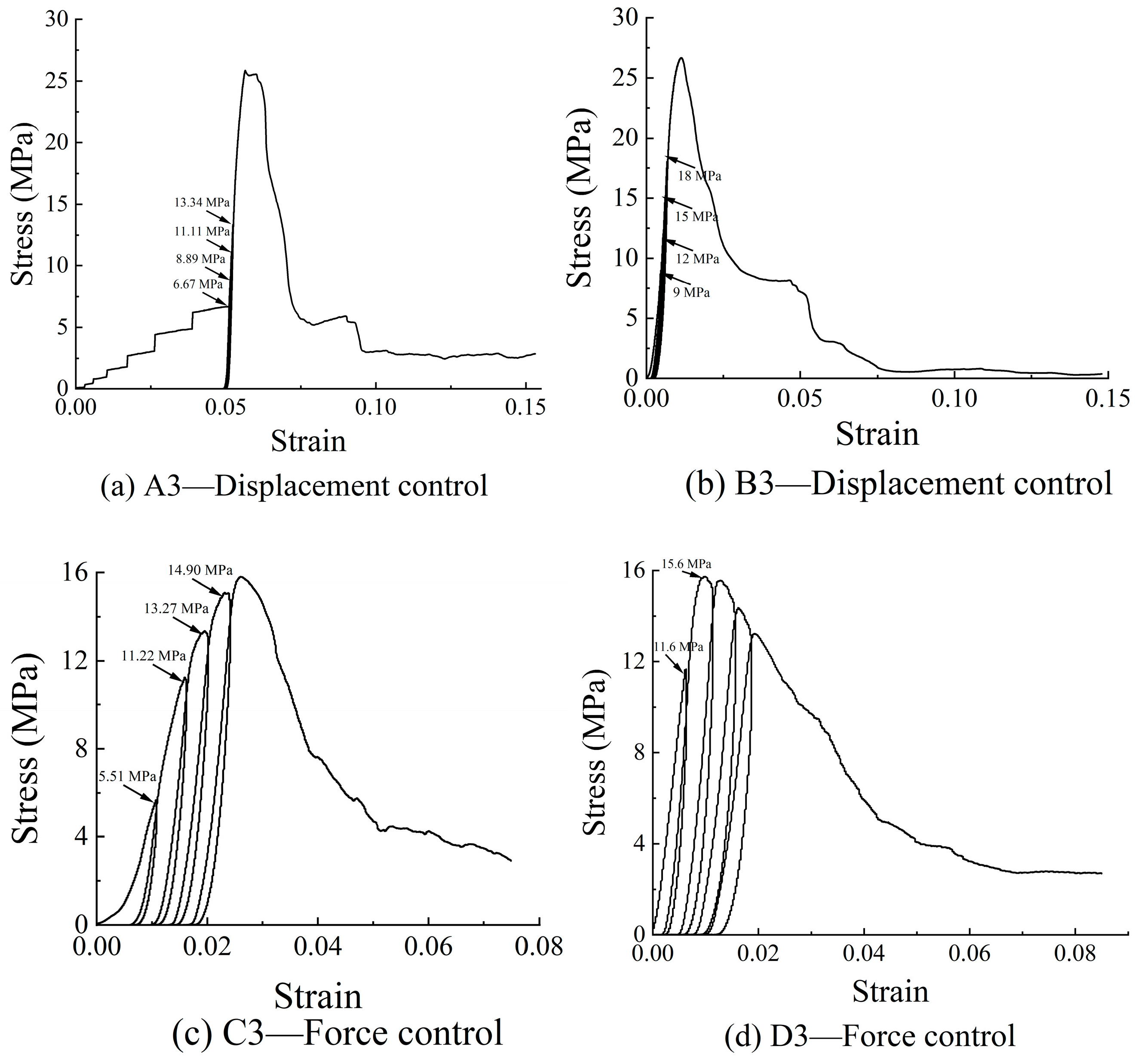
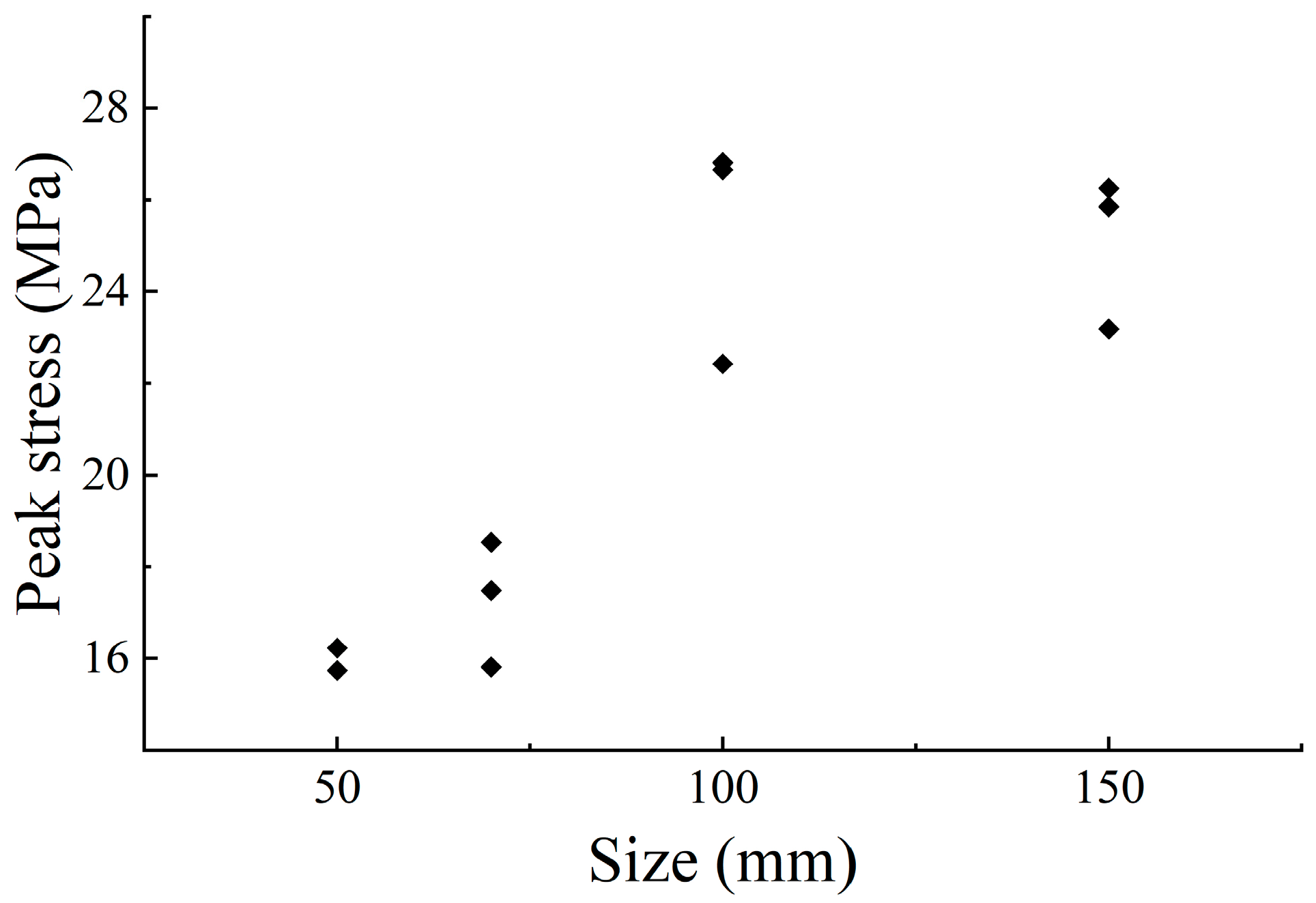



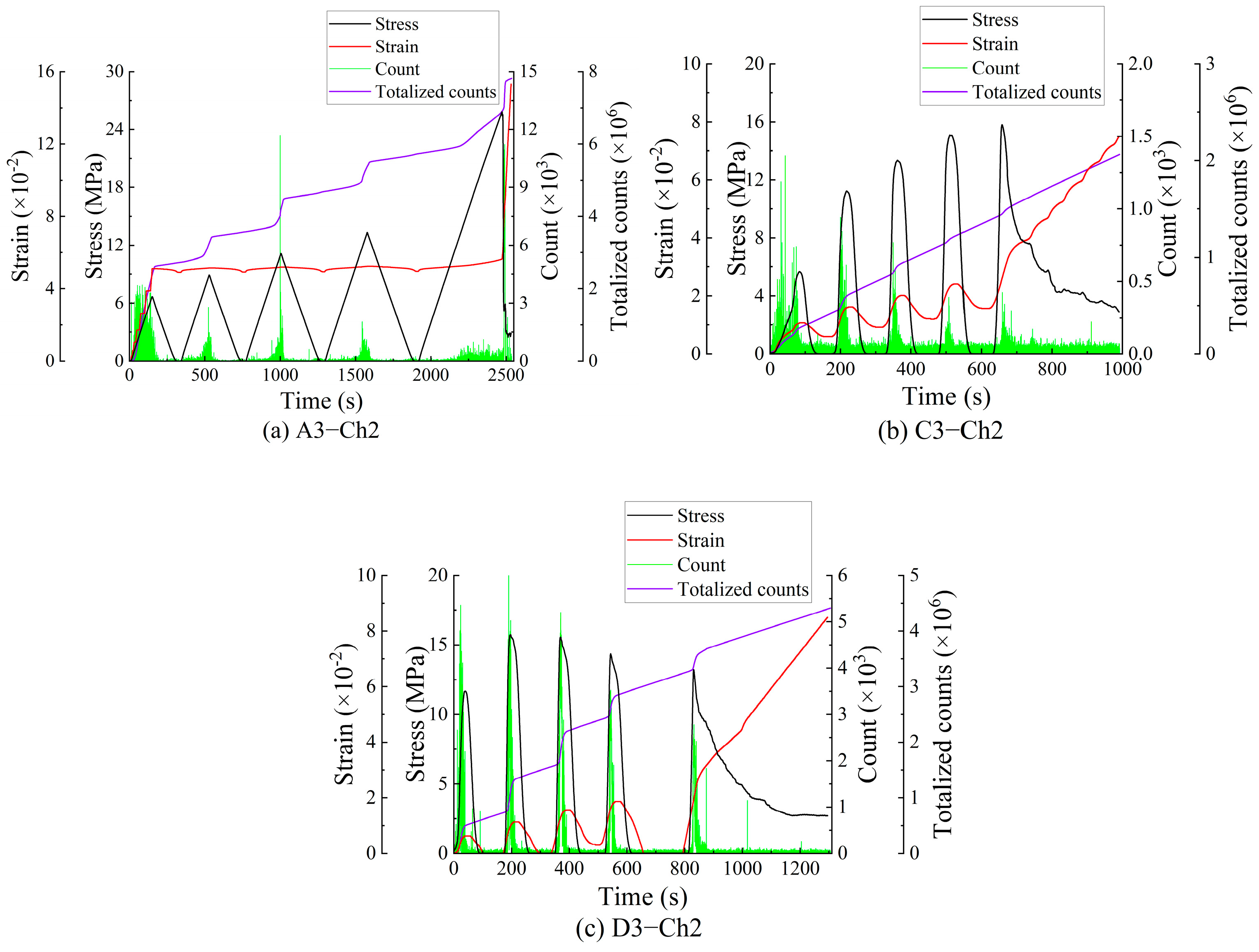

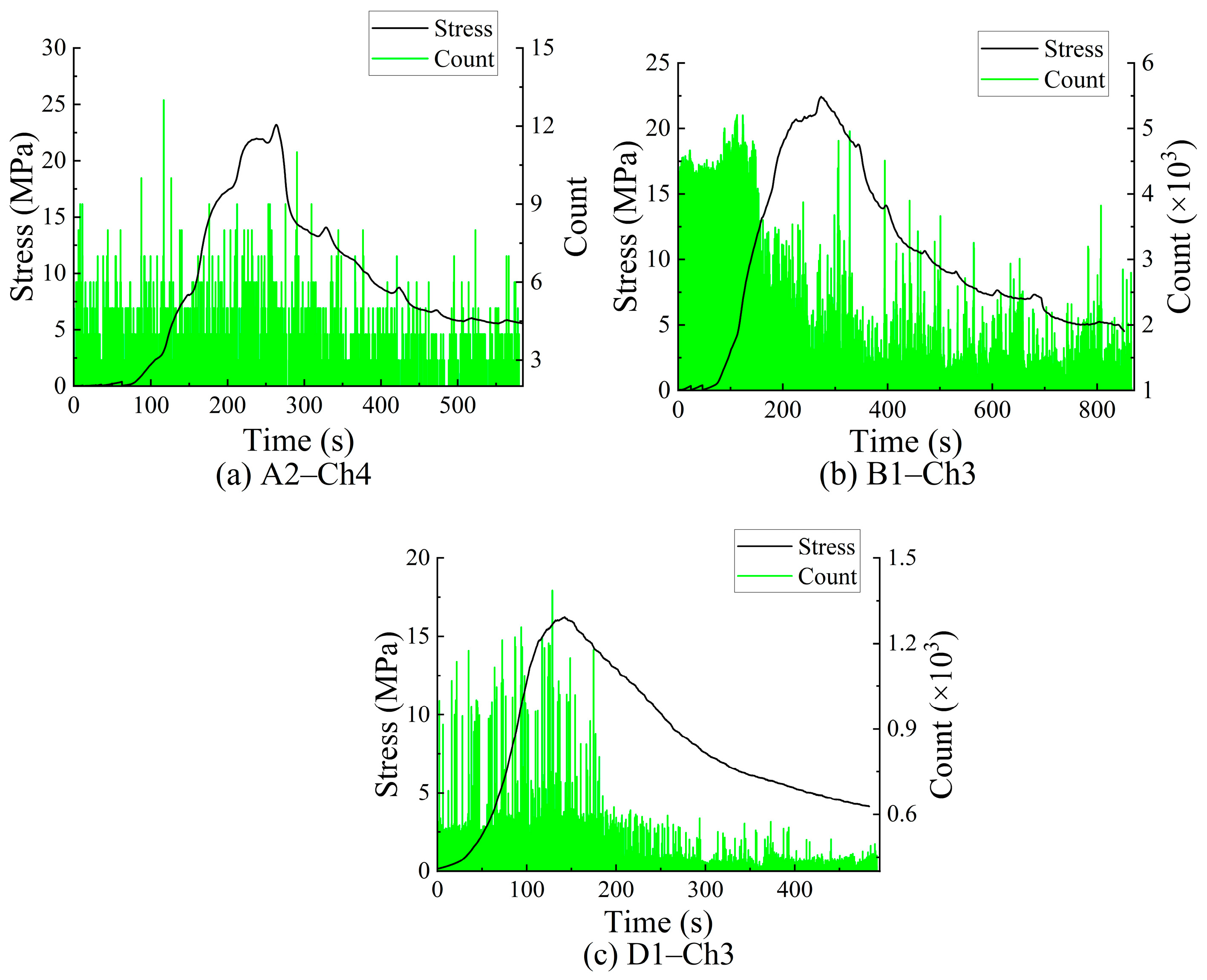


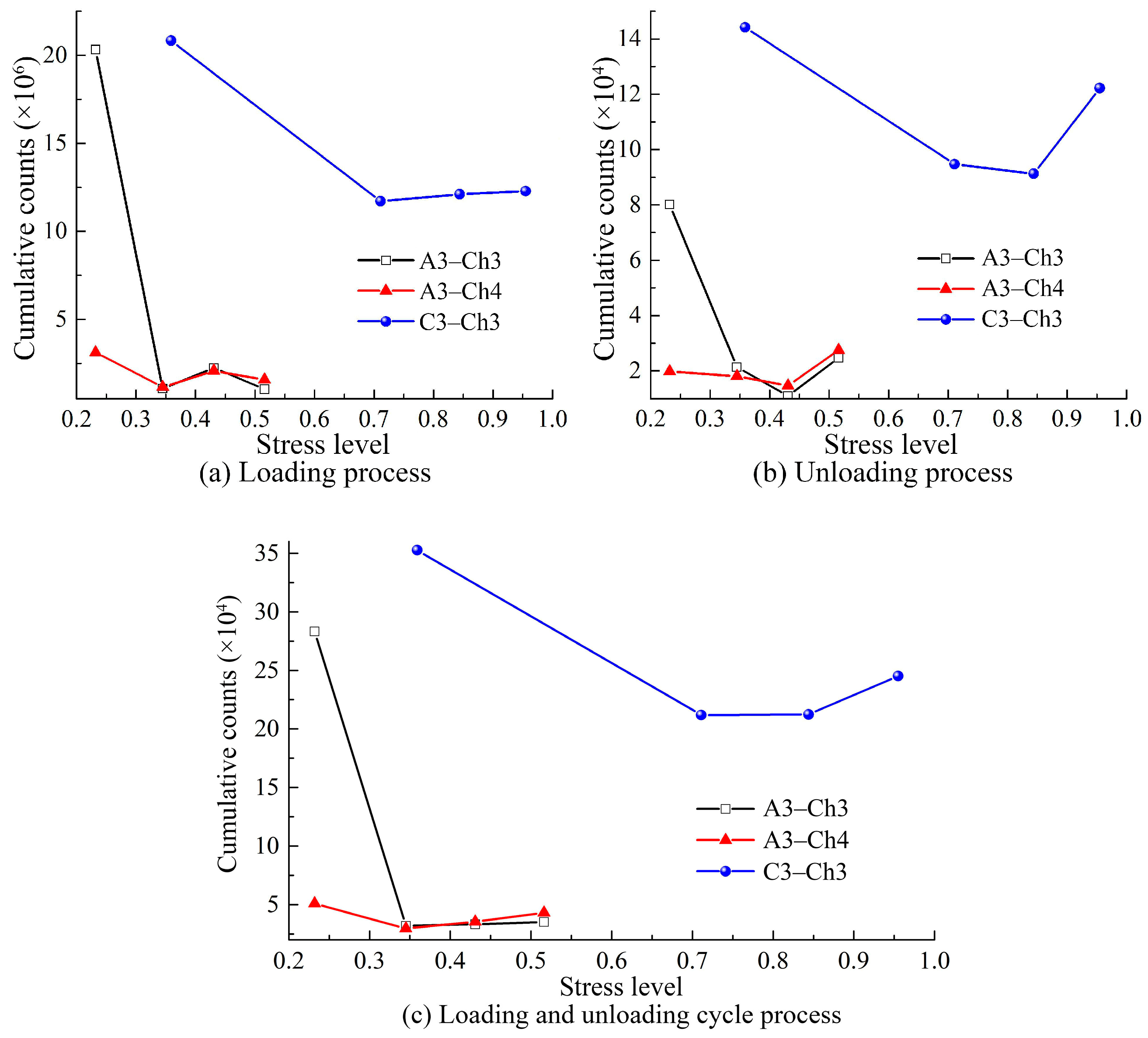


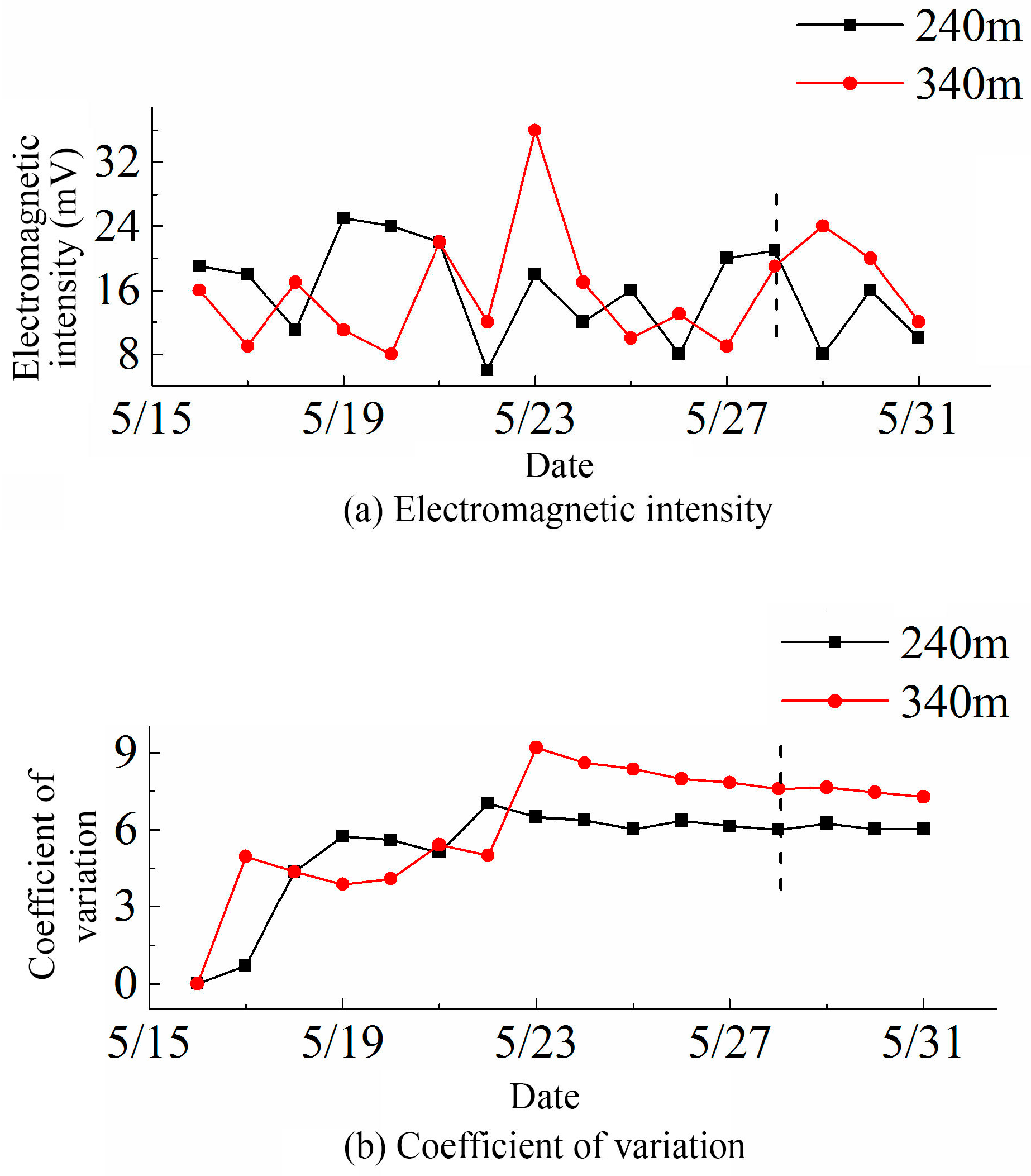
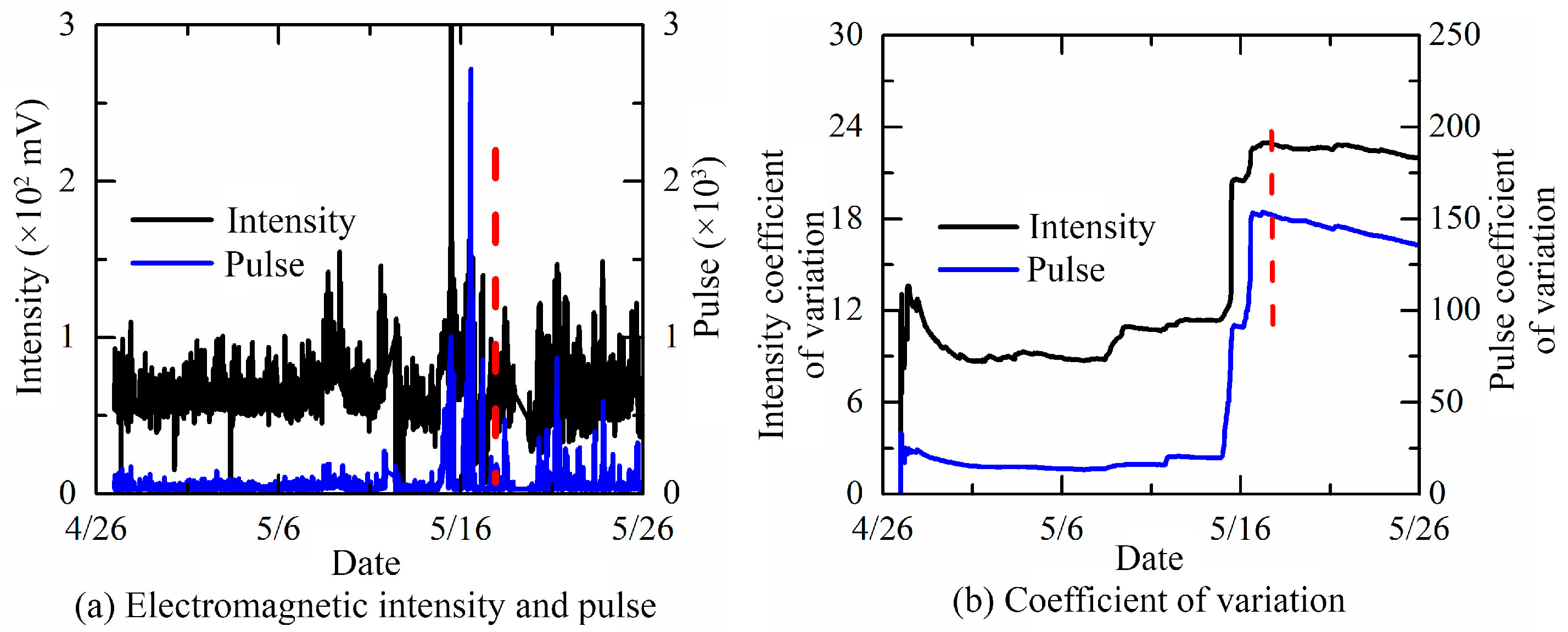

| Ingredient | Cement | Sand | Water |
|---|---|---|---|
| Weight ratio | 1 | 1.6 | 0.58 |
| Sample Size (mm) | Serial Number | Loading Method | Loading Rate |
|---|---|---|---|
| 150 × 150 × 150 | A1 | Uniaxial displacement control | 0.6 mm/min |
| A2 | |||
| A3 | Cyclic loading | Loaded at 1 kN/min to 150 kN (6.67 MPa); unloaded at the same speed to 0; loaded in the same way to 200, 250 and 300 kN (8.89, 11.11, 13.33 MPa), a total of four cycles; and then loaded to failure. | |
| 100 × 100 × 100 | B1 | Uniaxial displacement control | 0.4 mm/min |
| B2 | |||
| B3 | Cyclic loading | Loaded at 90, 120, 150 and 180 kN (9, 12, 15, 18 MPa) at the same rate as A3, and then loaded to failure. | |
| 70 × 70 × 70 | C1 | Uniaxial displacement control | 0.28 mm/min |
| C2 | |||
| C3 | Cyclic loading | Inflexion points of four cyclic loads are 27 kN (5.51 MPa), 55 kN (11.22 MPa), 65 kN (13.27 MPa) and 73 kN (14.90 MPa), respectively. | |
| 50 × 50 × 50 | D1 | Uniaxial displacement control | 0.2 mm/min |
| D2 | |||
| D3 | Cyclic loading | Inflexion points of four cyclic loads are 29 kN (11.6 MPa), 39 kN (15.6 MPa), 44 kN (17.6 MPa) and 49 kN (19.6 MPa), respectively. |
Publisher’s Note: MDPI stays neutral with regard to jurisdictional claims in published maps and institutional affiliations. |
© 2022 by the authors. Licensee MDPI, Basel, Switzerland. This article is an open access article distributed under the terms and conditions of the Creative Commons Attribution (CC BY) license (https://creativecommons.org/licenses/by/4.0/).
Share and Cite
Li, Z.; Lei, Y.; Wang, E.; Frid, V.; Li, D.; Liu, X.; Ren, X. Characteristics of Electromagnetic Radiation and the Acoustic Emission Response of Multi-Scale Rock-like Material Failure and Their Application. Foundations 2022, 2, 763-780. https://doi.org/10.3390/foundations2030052
Li Z, Lei Y, Wang E, Frid V, Li D, Liu X, Ren X. Characteristics of Electromagnetic Radiation and the Acoustic Emission Response of Multi-Scale Rock-like Material Failure and Their Application. Foundations. 2022; 2(3):763-780. https://doi.org/10.3390/foundations2030052
Chicago/Turabian StyleLi, Zhonghui, Yueyu Lei, Enyuan Wang, Vladimir Frid, Dexing Li, Xiaofei Liu, and Xuekun Ren. 2022. "Characteristics of Electromagnetic Radiation and the Acoustic Emission Response of Multi-Scale Rock-like Material Failure and Their Application" Foundations 2, no. 3: 763-780. https://doi.org/10.3390/foundations2030052
APA StyleLi, Z., Lei, Y., Wang, E., Frid, V., Li, D., Liu, X., & Ren, X. (2022). Characteristics of Electromagnetic Radiation and the Acoustic Emission Response of Multi-Scale Rock-like Material Failure and Their Application. Foundations, 2(3), 763-780. https://doi.org/10.3390/foundations2030052










